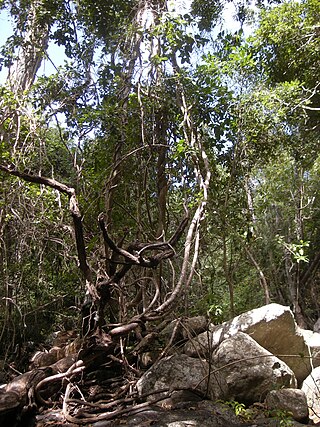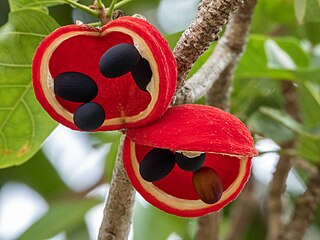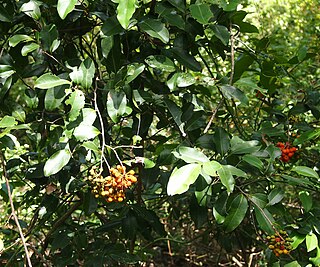Conway is a national park in Queensland, Australia, 911 km northwest of Brisbane. The park's main feature is the Conway Peninsula which is covered by the largest area of lowland tropical rainforest in Queensland outside Tropical North Queensland.

Eungella National Park is a protected area in Queensland, Australia. It is on the Clarke Range at the end of the Pioneer Valley 80 km west of Mackay, and 858 km northwest of Brisbane. Eungella is noted for the national park which surrounds it. It is considered to be the longest continual stretch of sub-tropical rainforest in Australia. The original inhabitants are the Wirri people. The park is covered by dense rainforest and is known for its platypuses.

Tropical and subtropical moist broadleaf forests (TSMF), also known as tropical moist forest, is a subtropical and tropical forest habitat type defined by the World Wide Fund for Nature.

A liana is a long-stemmed, woody vine that is rooted in the soil at ground level and uses trees, as well as other means of vertical support, to climb up to the canopy in search of direct sunlight. The word liana does not refer to a taxonomic grouping, but rather a habit of plant growth – much like tree or shrub. It comes from standard French liane, itself from an Antilles French dialect word meaning to sheave.

Austrobaileya is the sole genus consisting of a single species that constitutes the entire flowering plant family Austrobaileyaceae. The species Austrobaileya scandens grows naturally only in the Wet Tropics rainforests of northeastern Queensland, Australia.

Cissus is a genus of approximately 350 species of lianas in the grape family (Vitaceae). They have a cosmopolitan distribution, though the majority are to be found in the tropics.

Sterculia quadrifida, also known as the peanut tree, or red-fruited kurrajong is a small tree that grows in the rainforests, vine thickets, and gallery forests of New Guinea and northern Australia.
Allosyncarpia ternata, commonly known as an-binik, is a species of rainforest trees constituting part of the botanical family Myrtaceae and included in the eucalypts group. The only species in its genus, it was described in 1981 by Stanley Blake of the Queensland Herbarium. They grow naturally into large, spreading, shady trees, and are endemic to the Northern Territory of Australia. They grow in sandstone gorges along creeks emerging from the Arnhem Land plateau.

Uvaria leichhardtii, commonly known as zig-zag vine, is a species of vine in the family Annonaceae. It is native to parts of Malesia, New Guinea, and the eastern Australian states of Queensland and New South Wales.

Cissus antarctica(synonym Cissus oblongata), called "kangaroo vine", is one of the best known species of the genus Cissus in the family of Vitaceae. It is a climbing plant, a vine, and comes from Australia.

Cissus hypoglauca is a common Australian vine. It is one of the better known climbing plants of the genus Cissus in the grape family. A very common climber in moist areas of eastern Australia, it often colonises large areas after forest damage due to storms, fire or logging. Common names include jungle grape, water vine, giant water vine, five-leaf water vine, jungle vine, native grapes and billangai.

The Wingham Brush Nature Reserve is a protected nature reserve that is located in the Mid North Coast region of New South Wales, in eastern Australia. The 8-hectare (20-acre) reserve is a rare example of sub tropical lowland rainforest and is situated on the Manning River.

Cissus adnata is a woody vine species in the genus Cissus found in Asia and Australia.

Austrosteenisia blackii is a leguminous liana of the rainforests and dry rainforests of tropical and sub-tropical eastern Australia. Also known commonly as the blood vine for the dark red sap that exudes from cut stems. Blooms resemble dark red peas and produce papery fruit up to 12 cm long with kidney-shaped seeds. It is a vigorous creeper and can be used as ground cover in gardening. It is spectacular in bloom from September to December.

Cissus oblonga is a species of vine native to dry rainforests of Queensland, Australia.

Diplocyclos palmatus is a vine in the family Cucurbitaceae. It is commonly known as native bryony or striped cucumber. In Marathi, it is called shivlingi due to its seed which resembles a lingam.

Legnephora moorei, the round-leaf vine, is a species of plant in the family Menispermaceae. Endemic to the rainforests of Queensland and New South Wales, Australia. Round-leaf vine is a tall and large leafed climber usually noticed by fallen leaves on the rainforest floor. The southernmost limit of natural distribution is at Yatteyattah Nature Reserve on the south coast of New South Wales. The plant is one of the many named after Charles Moore.The stem of the vine can go up to 9 cm.

Clematicissus opaca, called small-leaf grape, pepper vine, small-leaved water vine, yaloone and wappo wappo, is a small vine endemic to Australia. Pepper vine is naturally found in rocky locales in monsoon forest, littoral rainforest and open forest, and is occasionally grown as a garden plant. The plant is primarily restricted to coastal and sub-coastal regions in Queensland and New South Wales, although it does occur inland, west of the Great Dividing Range, in central New South Wales,

Cissus sterculiifolia, the Yaroong is a widespread vine, though not particularly common. Found in rainforests north of Jervis Bay to Queensland in eastern Australia.
Australian Tropical Rainforest Plants, also known as RFK, is an identification key giving details—including images, taxonomy, descriptions, range, habitat, and other information—of almost all species of flowering plants found in tropical rainforests of Australia, with the exception of most orchids which are treated in a separate key called Australian Tropical Rainforest Orchids. A key for ferns is under development. RFK is a project initiated by the Australian botanist Bernie Hyland.


















